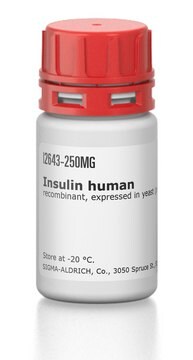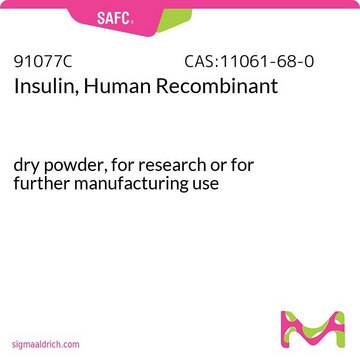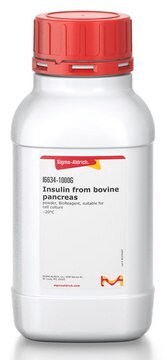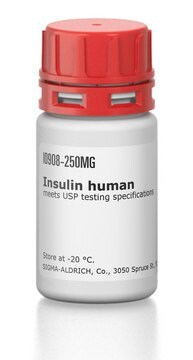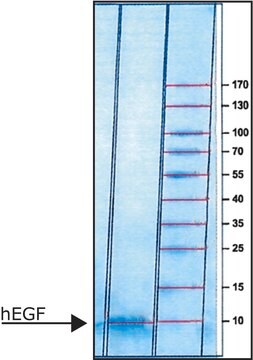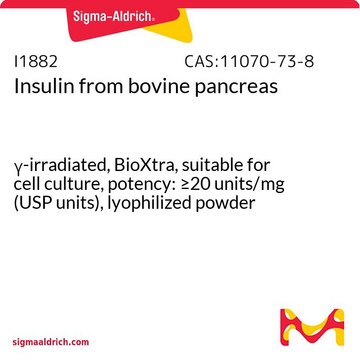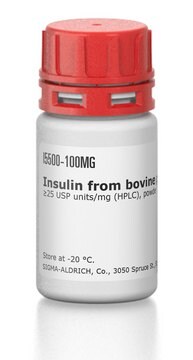I3536
Insulina
recombinant, expressed in yeast, γ-irradiated, suitable for cell culture
Sinonimo/i:
Insulin human
Autenticatiper visualizzare i prezzi riservati alla tua organizzazione & contrattuali
About This Item
Formula empirica (notazione di Hill):
C257H383N65O77S6
Numero CAS:
Peso molecolare:
5807.57
Numero MDL:
Codice UNSPSC:
12352209
NACRES:
NA.77
Prodotti consigliati
Origine biologica
Saccharomyces cerevisiae
Livello qualitativo
Ricombinante
expressed in yeast
Sterilità
γ-irradiated
Stato
lyophilized powder
Potenza
≥25 USP units per mg
tecniche
cell culture | mammalian: suitable
Solubilità
0.01 M HCl: 20 mg/mL, clear, colorless to faintly yellow
N° accesso UniProt
Condizioni di spedizione
ambient
Temperatura di conservazione
−20°C
InChI
PBGKTOXHQIOBKM-FHFVDXKLSA-N
Informazioni sul gene
human ... INS(3630)
Cerchi prodotti simili? Visita Guida al confronto tra prodotti
Categorie correlate
Descrizione generale
The INS gene encodes for preproinsulin, which is enzymatically converted into insulin. Insulin is produced in the insulin-producing pancreatic β cells. Preproinsulin is converted to proinsulin in ER and proinsulin is then proteolytically processed to form insulin in newly-forming insulin secretory granules. Insulin production is tightly regulated by specific DNA elements present within ∼400 bp in the proximal region of the INS promoter.
Applicazioni
Insulin human has been used for the following applications:
- For adipogenic differentiation assays (in the preparation of medium supplement)
- Incubation of cells for the evaluation of the effects of insulin
- Mass spectrometry (used for the external caliberation)
Azioni biochim/fisiol
Ormone polipeptidico a doppia catena prodotto dalle cellule β delle isole pancreatiche. Il suo peso molecolare è ~ 5800 Da. Le catene α e β sono unite da due ponti disolfuro interconnessi. La catena α contiene un ponte disolfuro interno. L′insulina regola l′assorbimento, l′utilizzazione e lo stoccaggio di glucosio, amminoacidi e acidi grassi e inibisce la rottura di glicogeno, proteine e grassi.
Regola l′assorbimento, l′utilizzazione e lo stoccaggio di glucosio, amminoacidi e acidi grassi e inibisce la rottura di glicogeno, proteine e grassi.
Insulin is responsible for two types of actions- excitatory and inhibitory. In its excitatory role, it increases the uptake of glucose and lipid synthesis, and in its inhibitory role it inhibits glycogenolysis, gluconeogenesis, lipolysis, proteolysis and ketogenesis. Aberrant insulin secretion leads to various disorders such as diabetes, hyperglycemia or hypoglycaemia. Type I diabetes is a result of autoimmune destruction of β cells of pancreas, which leads to depletion of insulin. Mutant INS-gene Induced Diabetes of Youth (MIDY) syndrome is an autosomal dominant disorder caused by missense mutations, which lead to aberrant proinsulin folding. Impaired glucose tolerance (IGT) or non-insulin-dependent diabetes mellitus (NIDDM) is caused by resistance to insulin-stimulated glucose uptake.
Altre note
InChI: 1S/C257H383N65O77S6/c1-29-131(23)205(313-193(339)104-259)252(393)317-204(130(21)22)248(389)288-159(75-82-200(349)350)217(358)282-156(71-78-189(263)335)221(362)308-183-116-403-404-117-184-243(384)305-178(111-324)240(381)294-162(88-123(7)8)225(366)295-168(95-140-53-61-146(329)62-54-140)228(369)283-154(69-76-187(261)333)218(359)290-161(87-122(5)6)223(364)285-158(74-81-199(347)348)220(361)302-174(101-190(264)336)235(376)298-170(97-142-57-65-148(331)66-58-142)231(372)309-182(242(383)304-176(255(396)397)103-192(266)338)115-402-401-114-181(214(355)273-107-194(340)278-153(72-79-197(343)344)216(357)281-151(51-42-84-271-257(267)268)212(353)272-108-195(341)279-166(93-138-46-36-32-37-47-138)227(368)297-167(94-139-48-38-33-39-49-139)230(371)299-171(98-143-59-67-149(332)68-60-143)238(379)320-208(135(27)327)254(395)322-85-43-52-186(322)246(387)286-152(50-40-41-83-258)222(363)321-209(136(28)328)256(398)399)311-250(391)203(129(19)20)316-236(377)164(90-125(11)12)292-229(370)169(96-141-55-63-147(330)64-56-141)296-224(365)160(86-121(3)4)289-210(351)133(25)277-215(356)157(73-80-198(345)346)287-247(388)202(128(17)18)315-237(378)165(91-126(13)14)293-233(374)173(100-145-106-270-120-276-145)301-239(380)177(110-323)280-196(342)109-274-213(354)180(113-400-405-118-185(310-244(183)385)245(386)319-207(134(26)326)253(394)306-179(112-325)241(382)318-206(132(24)30-2)251(392)312-184)307-226(367)163(89-124(9)10)291-232(373)172(99-144-105-269-119-275-144)300-219(360)155(70-77-188(262)334)284-234(375)175(102-191(265)337)303-249(390)201(127(15)16)314-211(352)150(260)92-137-44-34-31-35-45-137/h31-39,44-49,53-68,105-106,119-136,150-186,201-209,323-332H,29-30,40-43,50-52,69-104,107-118,258-260H2,1-28H3,(H2,261,333)(H2,262,334)(H2,263,335)(H2,264,336)(H2,265,337)(H2,266,338)(H,269,275)(H,270,276)(H,272,353)(H,273,355)(H,274,354)(H,277,356)(H,278,340)(H,279,341)(H,280,342)(H,281,357)(H,282,358)(H,283,369)(H,284,375)(H,285,364)(H,286,387)(H,287,388)(H,288,389)(H,289,351)(H,290,359)(H,291,373)(H,292,370)(H,293,374)(H,294,381)(H,295,366)(H,296,365)(H,297,368)(H,298,376)(H,299,371)(H,300,360)(H,301,380)(H,302,361)(H,303,390)(H,304,383)(H,305,384)(H,306,394)(H,307,367)(H,308,362)(H,309,372)(H,310,385)(H,311,391)(H,312,392)(H,313,339)(H,314,352)(H,315,378)(H,316,377)(H,317,393)(H,318,382)(H,319,386)(H,320,379)(H,321,363)(H,343,344)(H,345,346)(H,347,348)(H,349,350)(H,396,397)(H,398,399)(H4,267,268,271)/t131-,132-,133-,134+,135+,136+,150-,151-,152-,153-,154-,155-,156-,157-,158-,159-,160-,161-,162-,163-,164-,165-,166-,167-,168-,169-,170-,171-,172-,173-,174-,175-,176-,177-,178-,179-,180-,181-,182-,183-,184-,185-,186-,201-,202-,203-,204-,205-,206-,207-,208-,209-/m0/s1
Codice della classe di stoccaggio
13 - Non Combustible Solids
Classe di pericolosità dell'acqua (WGK)
WGK 2
Punto d’infiammabilità (°C)
Not applicable
Scegli una delle versioni più recenti:
Possiedi già questo prodotto?
I documenti relativi ai prodotti acquistati recentemente sono disponibili nell’Archivio dei documenti.
I clienti hanno visto anche
Y Nakamura et al.
British journal of pharmacology, 123(4), 675-682 (1998-03-28)
1. The actions of troglitazone, pioglitazone, metformin and bezafibrate, agents that improve insulin-resistance, on voltage-dependent Ca2+ channels in arterial smooth muscle cells were examined by use of the conventional and nystatin-perforated whole-cell clamp methods. Single cells were freshly isolated from
E Roine et al.
FEBS letters, 417(2), 168-172 (1997-12-12)
Pseudomonas syringae pv. tomato DC3000 produces Hrp pili under inducing in vitro conditions. A preparation of partially purified extracellular filaments contains HrpA, flagellin and some minor contaminants. HrpA was separated from the major contaminant, the flagellin, by gel filtration to
Insulin: understanding its action in health and disease.
P Sonksen et al.
British journal of anaesthesia, 85(1), 69-79 (2000-08-06)
Ming Liu et al.
PloS one, 5(10), e13333-e13333 (2010-10-16)
Recently, a syndrome of Mutant INS-gene-induced Diabetes of Youth (MIDY, derived from one of 26 distinct mutations) has been identified as a cause of insulin-deficient diabetes, resulting from expression of a misfolded mutant proinsulin protein in the endoplasmic reticulum (ER)
Swarup K Chakrabarti et al.
The Journal of biological chemistry, 278(26), 23617-23623 (2003-04-25)
Histone modifying enzymes contribute to the activation or inactivation of transcription by ultimately catalyzing the unfolding or further compaction, respectively, of chromatin structure. Actively transcribed genes are typically hyperacetylated at Lys residues of histones H3 and H4 and hypermethylated at
Il team dei nostri ricercatori vanta grande esperienza in tutte le aree della ricerca quali Life Science, scienza dei materiali, sintesi chimica, cromatografia, discipline analitiche, ecc..
Contatta l'Assistenza Tecnica.
